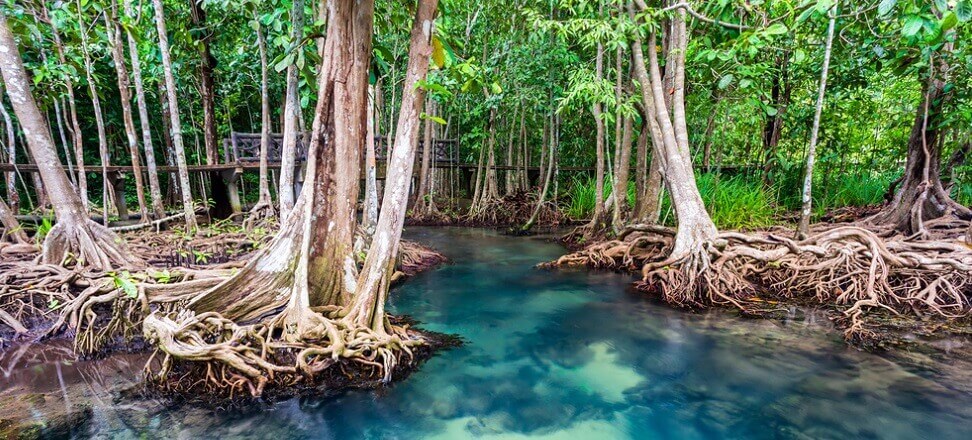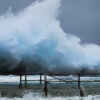Issue 14/2024, News
Drones to the rescue. A technological revolution in mangrove conservation
Although they occupy only 1 percent. of all rainforests, mangroves are crucial to protecting coastal ecosystems. As natural barriers, they protect coastlines from erosion and extreme weather events. Will an Abu Dhabi-based project that uses drones to plant mangroves have the desired effect? The ambitious plan aims to revolutionize conservation efforts by 2030.
Yesterday we celebrated the International Day for the Protection of the Ecosystem and Mangrove Forests, established by UNESCO in 2015. This annual holiday highlights the critical importance of mangroves to the global ecological balance. Although these forests are often seen as remote, they play a vital role in protecting biodiversity and preventing the effects of climate change by storing carbon and protecting coastlines.
Mangroves – unique ecosystems on the border between land and sea
Mangroves, also known as mangroves, are coastal ecosystems found in 121 countries, according to the
Currently known are approx. 80 species of mangrove trees, which form the so-called. organogenic shores. They are distinguished by a unique root system consisting of densely intertwined support roots and pneumatrophs – respiratory roots that enable them to survive in flooded and oxygen-poor soils and effectively filter salts from seawater.
Mangrove forests, the most abundant in the Asia-Pacific region (51 percent of global area), provide habitat for more than 1,533 different aquatic species. They also act as natural barriers to coastlines, preventing erosion caused by storms, waves and tides. In addition, they protect land from the effects of extreme weather events, such as tsunamis, and improve water quality by slowing tidal movement, which leads to sediment falling to the bottom of water bodies.
Importance of mangroves for climate and ecosystems
Mangrove forests play a key role in reducing greenhouse gas emissions. They are extremely effective at trapping and sequestering carbon dioxide from the atmosphere. Their disappearance could increaseCO2 emissions by up to 10 percent. Mangroves also have a positive impact on neighboring ecosystems, including seagrass meadows and coral reefs, supporting their health and functioning.
State of mangroves
Mangrove forests are threatened by human activities, including agricultural development, aquaculture and climate change. In 1996, mangroves covered 152,600 square kilometers of the Earth’s surface. Data from 2020, published by Global Mangrove Watch, shows a 3.4 percent decline in their coverage, to 147.35 thousand km². In addition, 12 mangrove species have been declared endangered and listed on the IUCN Red List.
Drones to the rescue of mangroves
Protecting mangroves is crucial to preserving coastal ecosystems, biodiversity and the coastal communities that depend on them. In response to these challenges, there are a growing number of initiatives aimed at restoring them. One example is a program underway in Abu Dhabi, United Arab Emirates.
The Abu Dhabi Mangrove Conservation Initiative (ADMI) was announced in February 2021. by the Environmental Defense Agency (EAD) and is being implemented in cooperation with local and international partners. The program aims to support a nationwide plan to plant 100 million mangroves by 2030. The ADMI project uses modern technology. In 2023. specially adapted drones have distributed more than 6 million mangrove tree seeds, launching them into the tidal mud. Advanced systems allow the drones to avoid straight planting lines and adapt to natural conditions, creating an optimal environment for young plants to grow.
The use of drones in the project increases its efficiency and environmental friendliness. Thanks to them, there is no need to establish mangrove nurseries, transport seedlings by internal combustion vehicles, or plant them by hand. Drones can also reach the most remote and hard-to-reach areas in need of restoration.
How do drones know where to plant trees?
Drones used to plant mangrove trees operate autonomously, using algorithms inspired by nature. The advanced systems analyze the terrain, avoiding existing trees and natural obstacles so that seeds are planted in optimal locations. The project is accompanied by the support of scientists who select the most favorable locations for planting, analyzing environmental conditions and monitoring the development of the project. Through these activities, coastal ecosystems in the UAE are gradually being restored.

 Polski
Polski







